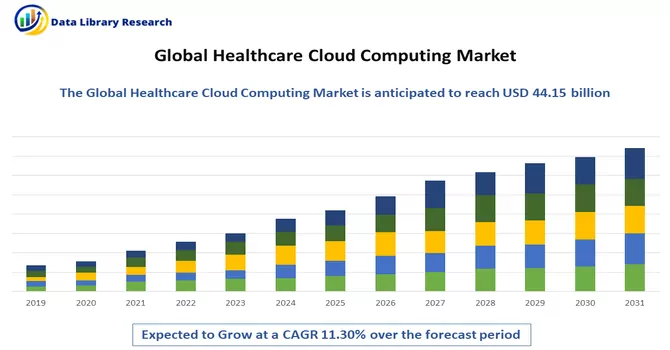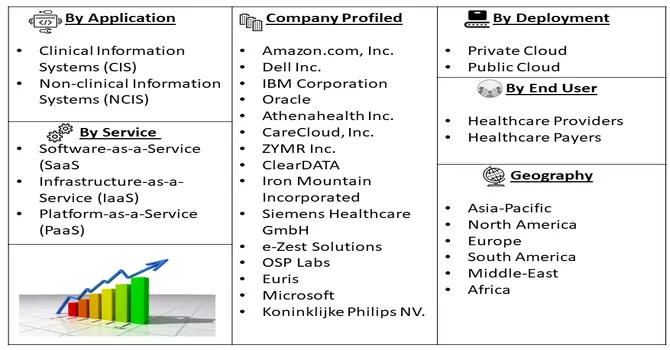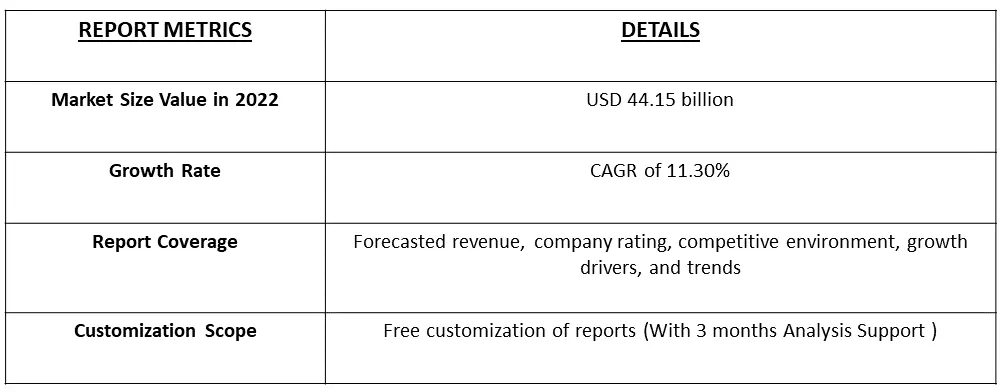The Healthcare Cloud Computing Market size is expected to grow from USD 44.15 billion in 2022 registering a CAGR of 11.30% during the forecast period (2023-2030).

Get Complete Analysis Of The Report - Download Free Sample PDF
Cloud computing in healthcare makes medical record-sharing easier and safer, automates backend operations, and even facilitates the creation and maintenance of telehealth apps. Utilizing the cloud increases the efficiency of the healthcare industry, while also decreasing costs.
The major factors bolstering the growth of the healthcare cloud computing market include increasing access to advanced technology, such as machine learning, the rise in the adoption of information technology in the healthcare sector, and the usage of the cloud for reducing cost and improving scalability, storage, and flexibility.
Healthcare cloud providers prioritize data security and compliance with industry regulations, such as the Health Insurance Portability and Accountability Act (HIPAA) in the United States. Cloud providers invest in robust security measures, encryption, and access controls to protect sensitive patient information. This focus on security allows healthcare organizations to leverage cloud computing without compromising data integrity.
Segmentation:
The Report Covers Global Healthcare Cloud Computing Market Analysis & Trends and it is Segmented
By Application :
Deployment :
Service :
End User :
Geography :

For Detailed Market Segmentation - Download Free Sample PDF
Drivers:
The adoption of cloud computing in healthcare offers numerous benefits, including scalability and access to advanced technologies, healthcare organizations must carefully navigate the associated challenges, particularly in terms of data security, interoperability, and compliance, to fully realize its potential for improving patient care and operational efficiency.
Increase in Adoption of Information Technology in Healthcare
The healthcare industry is increasingly embracing information technology to enhance patient care, streamline operations, and improve data management. Electronic health records (EHRs), telemedicine, and digital health solutions are driving the demand for cloud computing as a secure and scalable infrastructure to support these technologies. Cloud computing enables healthcare providers to access patient data and collaborate efficiently, leading to better clinical decision-making and patient outcomes. For instance, as per the report published by Philips in June 2022, 66% of healthcare leaders expect to move their technology infrastructures to the cloud in 2022, which is set to rise to 96% by 2024.
Access to Advanced Technology, such as Machine Learning, on Cloud Systems:
Cloud computing platforms offer healthcare organizations easier access to advanced technologies like machine learning and artificial intelligence (AI). Machine learning algorithms can analyze large healthcare datasets, providing insights into patient outcomes, disease prediction, and personalized treatment options. Cloud-based machine learning tools are cost-effective and facilitate faster innovation in healthcare analytics and diagnostics.
Restraints:
Data Privacy and Security Concerns:
Despite advancements in security measures, data breaches and privacy concerns remain significant challenges in healthcare cloud computing. The storage and transfer of sensitive patient data raise fears about unauthorized access, leading to potential legal and reputational risks. Achieving seamless interoperability between different healthcare systems and EHRs remains a complex issue, especially when data is stored across multiple cloud platforms. Data silos and incompatibility can hinder the efficient exchange of patient information. Thus, these factors may slow down the growth of the studied market over the forecast period.
The COVID-19 pandemic has had a significant impact on the healthcare industry, particularly in terms of managing a vast amount of data and meeting increasing demands. Cloud technology has emerged as a valuable solution for collecting, storing, and analyzing data to improve healthcare operations. By decentralizing the system, cloud-based solutions enable healthcare organizations to pay only for the resources they use. Cloud computing technologies also facilitate disease tracking, mapping, and public notifications, making it faster and more cost-effective. For example, in November 2022, the National Health Commission of the People’s Republic of China reported 1,794 new cases of COVID-19 in various areas of China. The adoption of cloud computing has made tracking and mapping the disease easier, and it is expected to have a positive impact on the market in the coming years, especially with the ongoing booster vaccination campaigns and the emergence of new COVID-19 cases.
Segmental Analysis :
EHR Segment is Expected to Witness Significant Growth Over the Forecast Period
Electronic Health Records (EHRs) have transformed the healthcare landscape by digitizing and centralizing patient information, making it easily accessible to healthcare providers. Recent developments in EHR technology have further enhanced their capabilities and impact on healthcare delivery.
The agreements and partnerships among the major players in the market towards cloud computing drive the market. For instance, in January 2022, Visionflex entered a partnership agreement with MediRecords, Australia’s provider of cloud-based electronic medical record and practice management systems. The partnership will see the companies work toward integrating Visionflex’s video conferencing platform, Vision, with MediRecords’ cloud-based electronic health record and practice management software platforms. By enabling better workflows and reducing ambiguity, interoperable EHR quickly allows data transfer between EHR systems and healthcare stakeholders. Thus, the market is expected to witness the largest market share in this segment over the forecast period due to the abovementioned factors.
Public Cloud by Deployment Segment is Expected to Witness Significant Growth Over the Forecast Period
The adoption of public cloud services in healthcare has been steadily increasing, driven by the need for scalability, cost-efficiency, and access to advanced technologies. Public cloud providers, such as Amazon Web Services (AWS), Microsoft Azure, and Google Cloud, offer a range of services that can benefit healthcare organizations. Public cloud services allow healthcare organizations to scale their IT infrastructure up or down as needed, ensuring they can handle fluctuating workloads, such as increased demand during a public health crisis. Thus, the segment is expected to witness significant growth over the forecast period.
Software-as-a-Service (SaaS) Segment is Expected to Witness Significant Growth over the Forecast Period
The adoption of Software-as-a-Service (SaaS) in the healthcare sector has brought about transformative changes, revolutionizing the way healthcare organizations manage operations, deliver patient care and leverage technology. SaaS applications are cloud-based solutions that are accessible over the internet, making them increasingly popular in healthcare. SaaS-based EHR systems have become a cornerstone of healthcare. These platforms enable healthcare providers to digitize patient records, streamline workflows, and ensure secure and centralized access to patient data.
Moreover, SaaS solutions for practice management and medical billing have simplified administrative tasks for healthcare facilities. These systems automate appointment scheduling, billing, and insurance claims processing, reducing paperwork and errors. Thus, due to these reasons, the market is expected to witness significant growth over the forecast period.
Healthcare Providers is Expected to Witness Significant Growth over the Forecast Period
Healthcare providers play a central and evolving role in the adoption and utilization of cloud computing technologies in the healthcare industry. The integration of cloud computing offers numerous benefits, but it also comes with responsibilities and considerations that healthcare providers must navigate. Healthcare providers are responsible for managing vast amounts of patient data, including electronic health records (EHRs), medical images, and clinical notes. Cloud computing provides a scalable and secure environment for storing and managing this data. Healthcare providers must ensure that patient data is appropriately encrypted, backed up, and compliant with data protection regulations like HIPAA (in the United States) or GDPR (in Europe). Thus, the segment is expected to witness significant growth over the forecast period.
North America Region is Expected to Witness Significant growth over the Forecast Period
The healthcare cloud computing market in North America holds a significant share and is expected to continue this trend over the forecast period. The United States, in particular, is a leader in this market, driven by the high adoption rate of healthcare IT services and continuous financial and regulatory support from government agencies. According to a report by Zivaro, an IT service management company, published in June 2022, the growth of medical data interoperability is a key driver of innovation in cloud computing.
Many healthcare organizations in the United States generate vast amounts of medical data, and cloud computing is widely used to handle this data. The complexity of HIPAA and HITECH governance rules for electronic Protected Health Information (ePHI) makes cloud computing an attractive solution. The report also highlights the ability to import and export data into shared database platforms, enabling secure information sharing within and outside a network architecture, and leveraging virtually unlimited cloud storage solutions.
Moreover, new partnerships and collaborations among major players in healthcare cloud computing are contributing to market growth. For example, in September 2022, LifePoint Health and Google Cloud announced a multi-year strategic partnership to transform healthcare delivery in communities across the United States. LifePoint Health will implement Google Cloud’s Healthcare Data Engine (HDE) to enhance healthcare services. Thus, the market is expected to witness significant growth over the forecast period.

Get Complete Analysis Of The Report - Download Free Sample PDF
The healthcare cloud computing market is moderately consolidated, owing to the presence of a few key players in the market. Companies are applying powerful competitive strategies to gain more market share. The companies are involved in various strategies such as product launches and investments in R&D activities to sustain themselves in the highly competitive environment. Some of the market players are:
Key Players :
Recent Development:
1. In November 2022, Wipro Ltd partnered with the United States-based cloud computing service provider VMware. The partnership will see Wipro maintain a VMware business unit to offer its clients the latter’s platform as a service. Wipro is training up to 5,000 professionals in VMware’s cross-cloud services, which will offer multi-cloud enterprise tools and focus on sectors such as banking, financial services and insurance (BFSI), healthcare, and consumer and retail services, as per the statement.
2. In June 2022, Saudi Arabia’s Ministry of Health (MoH) deployed multi-cloud solutions from VMware to transform the country’s public healthcare sector digitally. With this Ministry can offer secure, cloud-based services to public healthcare providers, including hospitals, clinics, and pharmacies, significantly boosting their efficiency and enabling them to grow and innovate.
Q1. What is the current Healthcare Cloud Computing Market size?
The Healthcare Cloud Computing Market size is currently USD 44.15 billion.
Q2. What is the Growth Rate of the Healthcare Cloud Computing Market?
Healthcare Cloud Computing Market is expected to grow at a CAGR of 11.30% during the forecast period.
Q3. Which Region is expected to hold the highest Market share?
North America region is expected to hold the highest Market share.
Q4. What Impact did COVID-19 have on the Healthcare Cloud Computing Market?
The COVID-19 pandemic has had a significant impact on the healthcare industry, particularly in terms of managing a vast amount of data and meeting increasing demands. For detailed insights request a sample here
Data Library Research are conducted by industry experts who offer insight on industry structure, market segmentations technology assessment and competitive landscape (CL), and penetration, as well as on emerging trends. Their analysis is based on primary interviews (~ 80%) and secondary research (~ 20%) as well as years of professional expertise in their respective industries. Adding to this, by analysing historical trends and current market positions, our analysts predict where the market will be headed for the next five years. Furthermore, the varying trends of segment & categories geographically presented are also studied and the estimated based on the primary & secondary research.
In this particular report from the supply side Data Library Research has conducted primary surveys (interviews) with the key level executives (VP, CEO’s, Marketing Director, Business Development Manager and SOFT) of the companies that active & prominent as well as the midsized organization
FIGURE 1: DLR RESEARH PROCESS

Extensive primary research was conducted to gain a deeper insight of the market and industry performance. The analysis is based on both primary and secondary research as well as years of professional expertise in the respective industries.
In addition to analysing current and historical trends, our analysts predict where the market is headed over the next five years.
It varies by segment for these categories geographically presented in the list of market tables. Speaking about this particular report we have conducted primary surveys (interviews) with the key level executives (VP, CEO’s, Marketing Director, Business Development Manager and many more) of the major players active in the market.
Secondary ResearchSecondary research was mainly used to collect and identify information useful for the extensive, technical, market-oriented, and Friend’s study of the Global Extra Neutral Alcohol. It was also used to obtain key information about major players, market classification and segmentation according to the industry trends, geographical markets, and developments related to the market and technology perspectives. For this study, analysts have gathered information from various credible sources, such as annual reports, sec filings, journals, white papers, SOFT presentations, and company web sites.
Market Size EstimationBoth, top-down and bottom-up approaches were used to estimate and validate the size of the Global market and to estimate the size of various other dependent submarkets in the overall Extra Neutral Alcohol. The key players in the market were identified through secondary research and their market contributions in the respective geographies were determined through primary and secondary research.
Forecast Model
